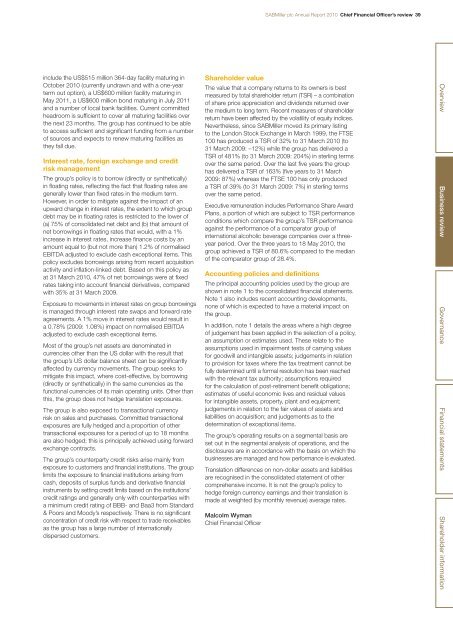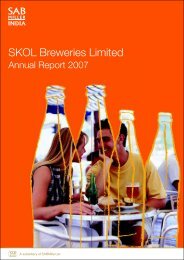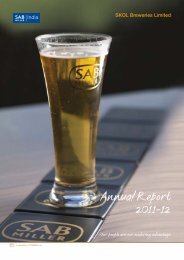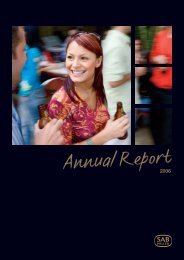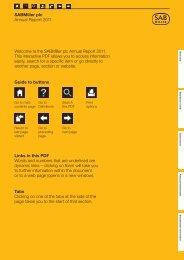Annual Report - SABMiller
Annual Report - SABMiller
Annual Report - SABMiller
- No tags were found...
You also want an ePaper? Increase the reach of your titles
YUMPU automatically turns print PDFs into web optimized ePapers that Google loves.
<strong>SABMiller</strong> plc <strong>Annual</strong> <strong>Report</strong> 2010 Chief Financial Officer’s review 39include the US$515 million 364-day facility maturing inOctober 2010 (currently undrawn and with a one-yearterm out option), a US$600 million facility maturing inMay 2011, a US$600 million bond maturing in July 2011and a number of local bank facilities. Current committedheadroom is sufficient to cover all maturing facilities overthe next 23 months. The group has continued to be ableto access sufficient and significant funding from a numberof sources and expects to renew maturing facilities asthey fall due.Interest rate, foreign exchange and creditrisk managementThe group’s policy is to borrow (directly or synthetically)in floating rates, reflecting the fact that floating rates aregenerally lower than fixed rates in the medium term.However, in order to mitigate against the impact of anupward change in interest rates, the extent to which groupdebt may be in floating rates is restricted to the lower of(a) 75% of consolidated net debt and (b) that amount ofnet borrowings in floating rates that would, with a 1%increase in interest rates, increase finance costs by anamount equal to (but not more than) 1.2% of normalisedEBITDA adjusted to exclude cash exceptional items. Thispolicy excludes borrowings arising from recent acquisitionactivity and inflation-linked debt. Based on this policy asat 31 March 2010, 47% of net borrowings were at fixedrates taking into account financial derivatives, comparedwith 35% at 31 March 2009.Exposure to movements in interest rates on group borrowingsis managed through interest rate swaps and forward rateagreements. A 1% move in interest rates would result ina 0.78% (2009: 1.08%) impact on normalised EBITDAadjusted to exclude cash exceptional items.Most of the group’s net assets are denominated incurrencies other than the US dollar with the result thatthe group’s US dollar balance sheet can be significantlyaffected by currency movements. The group seeks tomitigate this impact, where cost-effective, by borrowing(directly or synthetically) in the same currencies as thefunctional currencies of its main operating units. Other thanthis, the group does not hedge translation exposures.The group is also exposed to transactional currencyrisk on sales and purchases. Committed transactionalexposures are fully hedged and a proportion of othertransactional exposures for a period of up to 18 monthsare also hedged; this is principally achieved using forwardexchange contracts.The group’s counterparty credit risks arise mainly fromexposure to customers and financial institutions. The grouplimits the exposure to financial institutions arising fromcash, deposits of surplus funds and derivative financialinstruments by setting credit limits based on the institutions’credit ratings and generally only with counterparties witha minimum credit rating of BBB- and Baa3 from Standard& Poors and Moody’s respectively. There is no significantconcentration of credit risk with respect to trade receivablesas the group has a large number of internationallydispersed customers.Shareholder valueThe value that a company returns to its owners is bestmeasured by total shareholder return (TSR) – a combinationof share price appreciation and dividends returned overthe medium to long term. Recent measures of shareholderreturn have been affected by the volatility of equity indices.Nevertheless, since <strong>SABMiller</strong> moved its primary listingto the London Stock Exchange in March 1999, the FTSE100 has produced a TSR of 32% to 31 March 2010 (to31 March 2009: –12%) while the group has delivered aTSR of 481% (to 31 March 2009: 204%) in sterling termsover the same period. Over the last five years the grouphas delivered a TSR of 163% (five years to 31 March2009: 87%) whereas the FTSE 100 has only produceda TSR of 39% (to 31 March 2009: 7%) in sterling termsover the same period.Executive remuneration includes Performance Share AwardPlans, a portion of which are subject to TSR performanceconditions which compare the group’s TSR performanceagainst the performance of a comparator group ofinternational alcoholic beverage companies over a threeyearperiod. Over the three years to 18 May 2010, thegroup achieved a TSR of 80.6% compared to the medianof the comparator group of 28.4%.Accounting policies and definitionsThe principal accounting policies used by the group areshown in note 1 to the consolidated financial statements.Note 1 also includes recent accounting developments,none of which is expected to have a material impact onthe group.In addition, note 1 details the areas where a high degreeof judgement has been applied in the selection of a policy,an assumption or estimates used. These relate to theassumptions used in impairment tests of carrying valuesfor goodwill and intangible assets; judgements in relationto provision for taxes where the tax treatment cannot befully determined until a formal resolution has been reachedwith the relevant tax authority; assumptions requiredfor the calculation of post-retirement benefit obligations;estimates of useful economic lives and residual valuesfor intangible assets, property, plant and equipment;judgements in relation to the fair values of assets andliabilities on acquisition; and judgements as to thedetermination of exceptional items.The group’s operating results on a segmental basis areset out in the segmental analysis of operations, and thedisclosures are in accordance with the basis on which thebusinesses are managed and how performance is evaluated.Translation differences on non-dollar assets and liabilitiesare recognised in the consolidated statement of othercomprehensive income. It is not the group’s policy tohedge foreign currency earnings and their translation ismade at weighted (by monthly revenue) average rates.Malcolm WymanChief Financial OfficerOverview Business reviewGovernance Financial statements Shareholder information


